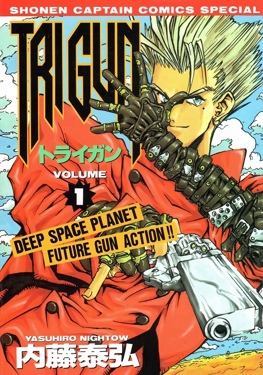
Trigun is a Japanese manga series written and illustrated by Yasuhiro Nightow. It was first serialized in Tokuma Shoten's shōnen manga magazine Monthly Shōnen Captain from March 1995 to December 1996, until the magazine ceased its publication; its chapters were collected in three tankōbon volumes. The series continued its publication in Shōnen Gahosha's seinen manga magazine Young King OURs, under the title Trigun Maximum, from October 1997 to March 2007. Shōnen Gahosha republished the Trigun chapters in two volumes, and collected the Trigun Maximum chapters in 14 volumes.

Magic Knight Rayearth is a Japanese manga series created by CLAMP. Appearing as a serial in the manga magazine Nakayoshi from the November 1993 issue to the February 1995 issue, the chapters of Magic Knight Rayearth were collected into three bound volumes by Kodansha, and were published from July 1994 to March 1995. A sequel was serialized in the same manga magazine from the March 1995 issue to the April 1996 issue, and was published by Kodansha in three bound volumes from July 1995 to April 1996.

Weekly Shōnen Jump is a weekly shōnen manga anthology published in Japan by Shueisha under the Jump line of magazines. The manga series within the magazine consist of many action scenes and a fair amount of comedy. Chapters of the series that run in Weekly Shōnen Jump are collected and published in tankōbon volumes under the Jump Comics imprint every two to three months. It is one of the longest-running manga magazines, with the first issue being released with a cover date of August 1, 1968.

Tokyopop is an American distributor, licensor and publisher of anime, manga, manhwa and Western manga-style works. The German publishing division produces German translations of licensed Japanese properties and original English-language manga, as well as original German-language manga. Tokyopop's US publishing division publishes works in English. Tokyopop has its US headquarters near Los Angeles International Airport in Los Angeles, California. Its parent company's offices are in Tokyo, Japan and its sister company's office is in Hamburg, Germany.
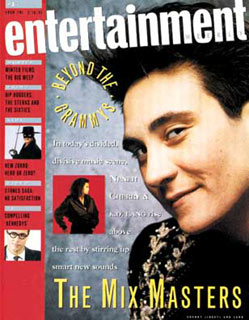
Entertainment Weekly is an American digital-only entertainment magazine based in New York City, published by Dotdash Meredith, that covers film, television, music, Broadway theatre, books, and popular culture. The magazine debuted on February 16, 1990, in New York City, and ceased print publication in 2022.

Newtype is a monthly magazine publication originating from Japan, covering anime. It was launched by publishing company Kadokawa Shoten on March 8, 1985, with its April issue, and has since seen regular release on the 10th of every month in its home country. Newtype Korea is published in Korea. Spin-off publications of Newtype also exist in Japan, such as Newtype Hero/Newtype the Live and NewWORDS, as well as numerous limited-run versions.

Animerica was a monthly magazine published by Viz Media containing news, feature articles, and reviews on manga, anime, and related media, as well as a section that serialized manga published by Viz. After an initial November 1992 preview issue, Animerica's first regular issue was released in February 1993 with a March 1993 cover date. In 1998, Animerica Extra was launched as a separate manga anthology magazine which eventually focused specifically on shōjo titles. It was canceled in 2004.
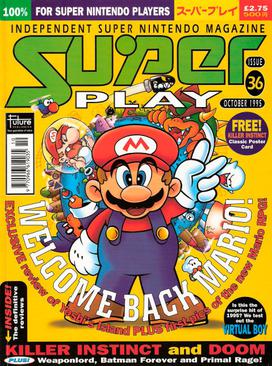
Super Play was a British Super Nintendo Entertainment System (SNES) magazine which ran from 1 October 1992 to September 1996.

Wizard Entertainment Inc., formerly known as GoEnergy and Wizard World, is a producer of multi-genre fan conventions across North America. The company started as the holding company for Strato Malmas' interests in the energy business.

Wizard or Wizard: The Magazine of Comics, Entertainment and Pop Culture was a magazine about comic books, published monthly in the United States by Wizard Entertainment from July 1991 to January 2011. It included a price guide, as well as comic book, movie, anime, and collector news, interviews, and previews.

Enterbrain (エンターブレイン), formerly Enterbrain, Inc., is a Japanese publisher and division of Kadokawa Future Publishing founded on 30 January 1987 as ASCII Film Co., Ltd.. Magazines published by Enterbrain are generally focused on video games and computer entertainment as well as video game and strategy guides. In addition, the company publishes a small selection of anime artbooks. Enterbrain is based in Tokyo, Japan, with a paid-in capital of 410 million yen. Enterbrain's current president is Hirokazu Hamamura.
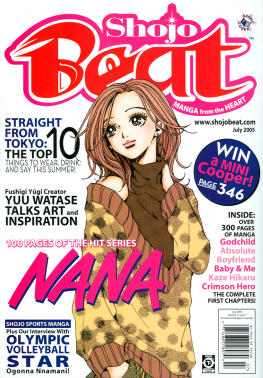
Shojo Beat is a shōjo manga magazine formerly published in North America by Viz Media. Launched in June 2005 as a sister magazine for Shonen Jump, it featured serialized chapters from six manga series, as well as articles on Japanese culture, manga, anime, fashion and beauty. After its initial launch, Shojo Beat underwent two redesigns, becoming the first English anthology to use the cyan and magenta ink tones common to Japanese manga anthologies. Viz launched a related imprint of the same name for female-oriented manga, light novels and anime.

Hakusensha, Inc. is a Japanese publishing company. It is headquartered in Chiyoda, Tokyo.

Shadow Skill is a Japanese manga series written and illustrated by Megumu Okada. The series has been adapted into four original video animations released from 1995 to 1996 and an anime adaptation produced by Studio Deen aired on TV Tokyo in 1998.

Fairy Tail is a Japanese manga series written and illustrated by Hiro Mashima. It was serialized in Kodansha's Weekly Shōnen Magazine from August 2006 to July 2017, with the individual chapters collected and published into 63 tankōbon volumes. The story follows the adventures of Natsu Dragneel, a member of the popular wizard guild Fairy Tail, as he searches the fictional world of Earth-land for the dragon Igneel.
Akita Publishing Co., Ltd. is a Japanese publishing company headquartered in Chiyoda, Tokyo. It was founded by Teio Akita in 1948. As of May 2023, the company's president is Shigeru Higuchi. The company is known for publishing the manga magazine Weekly Shōnen Champion, which serialized works such as Osamu Tezuka's Black Jack, Keisuke Itagaki's Baki the Grappler, and Shinji Mizushima's Dokaben.
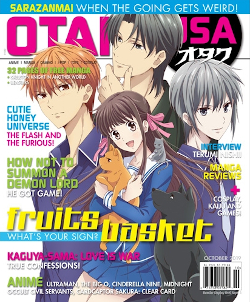
Otaku USA is a bimonthly magazine published by Sovereign Media, which covers various elements of the "otaku" lifestyle from an American perspective. The issues were accompanied by a DVD featuring three anime episodes but as of 2009 the DVD feature was dropped and the double sided poster feature of the Magazine was also dropped starting with the February 2010 issue.

Shugo Chara!, also known as My Guardian Characters, is a Japanese shōjo manga series created by the manga author duo, Peach-Pit. The story centers on elementary school girl Amu Hinamori, whose popular exterior, referred to as "cool and spicy" by her classmates, contrasts with her introverted personality. When Amu wishes for the courage to be reborn as her would-be self, she is surprised to find three colorful eggs the next morning, which hatch into three Guardian Characters: Ran, Miki, and Su.

Shonen Jump, officially stylized SHONEN JUMP and abbreviated SJ, was a shōnen manga anthology published in North America by Viz Media. It debuted in November 2002 with the first issue having a January 2003 cover date. Based on Shueisha's popular Japanese magazine Weekly Shōnen Jump, Shonen Jump is retooled for English readers and the American audience, including changing it from a weekly publication to a monthly one. It features serialized chapters from four manga series, and articles on Japanese language and culture, as well as manga, anime, video games, and figurines. Prior to the magazine's launch, Viz launched an extensive marketing campaign to promote it and help it succeed where previous manga anthologies published in North America had failed. Shueisha purchased an equity interest in Viz to help fund the venture, and Cartoon Network, Suncoast, and Diamond Distributors became promotional partners in the magazine.

Shueisha Inc. is a Japanese company headquartered in Chiyoda, Tokyo, Japan. Shueisha is the largest publishing company in Japan. It was established in 1925 as the entertainment-related publishing division of Japanese publisher Shogakukan. The following year, Shueisha became a separate, independent company.


















